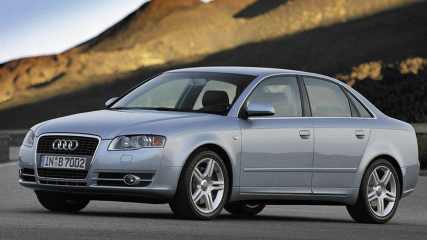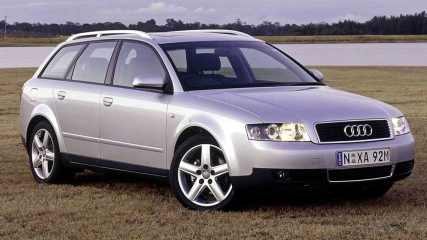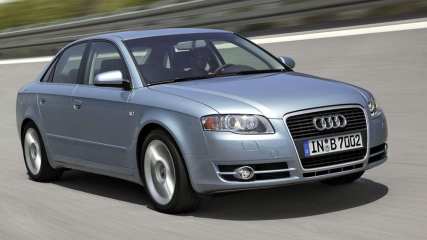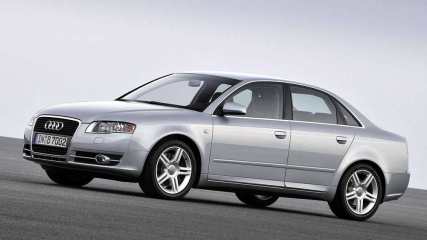Audi A4 2.0 TFSI 2005 Review
By CarsGuide team · 30 Jun 2005
The revised A4 follows Audi's new corporate face. Curves are back in fashion. When we first reviewed the car in 2001, we talked of its "cold-eyed teutonic look". That look has been warmed up with curves replacing straight lines and a prominent grille, clearly inspired by the fronts of the 1930s Auto Union racing cars from which Audi claims descent. The effect is a sort of fishy appearance – streamlined, but organic.Inside, a new steering wheel mimics the shape of the deep grille in its hub design, although many elements of the old car are still recognisable. The cabin remains a dark, elegant and tasteful place, one imagines an avant garde hotel in Berlin.It's reasonably roomy in the front seats, which disappointingly for the money lack power adjustment. But the rear remains a tight, two-adults-only space, despite some work to recover a bit of knee room from the seatbacks. The boot, by contrast, is large, at 460 litres.The A4 is one of five main Audi models but it is almost a model range in itself. By the end of the year there will be 16 versions, each a distinct variation.The car we drove was the 2.0 TFSI, standing for turbocharged fuel stratified injection. Audi expects it to account for about 15 per cent of demand for the A4. It expects the lion's share of buyers to go for the older non-turbo 2.0-litre version but there's also a 1.8-litre turbo engine available and, at the top of the range, a 3.2-litre V6. Eventually, we'll see a 2.0-litre diesel.But for now the 2.0-litre TFSI engine is the highlight of the four-cylinder options. It uses direct petrol injection, which means fuel is squirted into the cylinder rather than the inlet tube. This enables very lean and economical running at low engine speeds, combined with power at higher revs. It's the same engine Audi's sibling brand Volkswagen uses in the Golf GTI, and it's equally impressive under an Audi bonnet.Fuel use, as monitored by the computer, can dip below seven litres per 100km although our measured average use of 10.5 litres per 100km was less than exceptional. We'll forgive it, though, for its broad torque spread and the way it always feels like a larger engine in either gentle or hard use.The multitronic transmission, having proved itself with Audi's more modest engines, now appears behind the 147kW 2.0-litre TFSI. Multitronic is Audi's word for a continuously variable transmission. A CVT is not, strictly speaking, a gearbox because it uses belts, not gears, to send power to the wheels. The principle is as delightfully simple as the details are damnably complex. A belt connects two pulleys which can change in size. One is connected to the engine, the other to the wheels.When the engine pulley is small and the wheel pulley is large the car is in "bottom gear". When the engine pulley is at its largest and the wheel pulley is at its smallest the car is in top gear. Instead of specific gears the transmission can use any combination of sizes between the two extremes to produce any number of drive ratios.The result, when combined with the impressively flat torque curve of the TFSI engine, can be amusing. There's a distinct rubber band effect if you accelerate briskly with the engine note remaining constant as the transmission constantly and seamlessly shifts up. A clever piece of programming means in sport mode the system also produces a significant degree of engine braking.If you tick the sport option pack for $1800 you get Audi's neat little paddle shifters on the steering wheel controlling seven nominal speeds in the transmission (they're not real gears, just fixed settings for the pulleys). The system holds gears until the redline before changing up, but in practice it's just as quick to select sport mode and let the transmission do its thing. Seven gears is one too many to think about.Multitronic is a most impressive auto in all situations but one: it can be hesitant when creeping along at under walking pace, such as when squeezing into a tight parking spot.Audi says it has paid attention to the A4's ride and there's little to complain about in the latest model. The car tested had the optional and stiffer sports suspension but it was never jiggling or jarring. Although the optional larger tyres produced a fair bit of road rumble, the suspension remained quiet and reasonably compliant over bumps.Handling is less of a success. Mostly it's fine but the front-drive turbo A4 doesn't care for the combination of rough roads and tight bends. It can have problems getting its power down, with wheel hop audible from the cabin and it slouches into understeer more easily than it should. But the brakes are both strong and modulated, without the over-servoed feeling that has made some previous Audis difficult to drive smoothly.The steering stays free of the kickback that has at times blighted Audis, and while it feels a little clinical it's sensitive around straight ahead and well geared for twisty roads.Despite the brilliance of the multitronic transmission we ended up wondering how much better this car would be in quattro form. Losing the multitronic gearbox for a conventional six-speed might be a fair price to pay for picking up two more driving wheels. In that form it is both alternative and rival to the German top two.Verdict:






